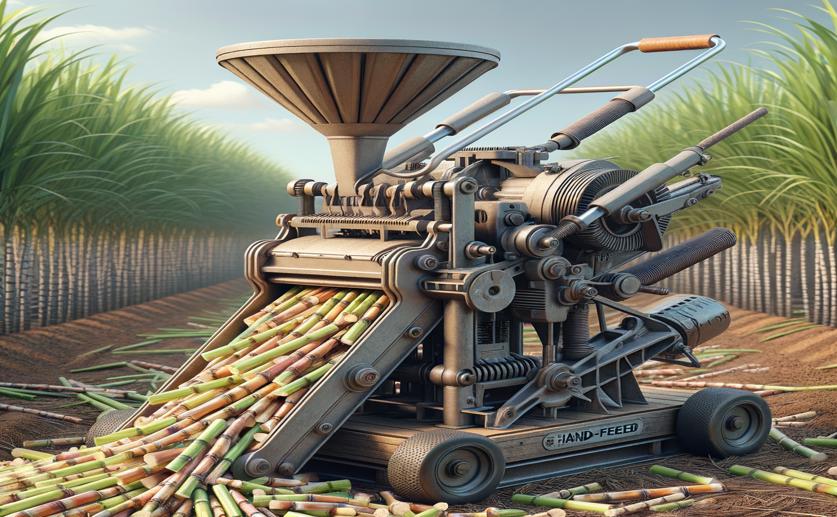Hand-Feed Sugarcane Chipper: Design and Field Tests

Image Source: Natural Science News, 2024
Key Findings
- In Egypt, a new semi-automatic bud chipper improves sugarcane planting by efficiently cutting buds
- Best cutting results were with a 1.5 mm knife at speeds below 50 rpm, minimizing bud damage
- The chipper's max productivity reached 110 buds per minute at the lowest speed and smallest stalk diameter
In recent years, the agricultural industry has been leaning towards automation and precision farming to increase efficiency and reduce labor costs. One crop that has seen significant attention in this regard is sugarcane, a primary source of sugar. In Egypt, sugarcane is a vital agricultural product, but its planting methods have been fraught with issues like low cutting efficiency and subpar quality, which ultimately affect the crop's yield and profitability. Researchers from Aswan University have taken on the challenge to innovate the sugarcane planting process with a new study[1].
The focus of the Aswan University study was on designing and constructing a semi-automatic sugarcane bud chipper. This machine is equipped with pivot knives, which are designed to cut sugarcane buds efficiently. The buds are then allowed to germinate in plastic trays within a greenhouse setting until they reach an average length of 35 cm. After this initial growth phase, the buds are transplanted into the field.
Field tests were conducted to optimize the performance of the bud chipper. Variables such as cutting speeds, which ranged from 35 to 56 revolutions per minute (rpm), and knife thicknesses of 1.5, 2.0, and 2.5 mm were tested on sugarcane stalks with diameters between 1.32 and 2.68 cm. The results of these tests showed that the damage index and invisible losses were within acceptable limits for all the tested variables. Notably, the best outcomes, characterized by the lowest damage index and invisible losses, were achieved using a knife thickness of 1.5 mm at cutting speeds below 50 rpm.
One of the challenges identified was the skipping rate, which refers to the machine's tendency to miss buds during cutting. This rate increased with both the cutting speed and the stalk diameter. The skipping rate varied from 0.0 to 13%, indicating that some optimization was still required, particularly at higher speeds and with thicker stalks.
The study found that the maximum productivity of the machine was 110 buds per minute at the lowest cutting speed of 35 rpm and with the smallest stalk diameter of 1.32 cm. These findings have significant implications for the design and development of sugarcane planting technology, particularly as it relates to the semiautomatic bud chipper.
The Aswan University study builds upon earlier research that sought to address similar issues in the sugarcane planting process. A previous study[2] introduced an automatic sugarcane-seed-cutting system that incorporated a visual inspection system using the YOLO V5 network model. This system was designed to identify the eustipes (the joint between the leaf sheath and the stem in grasses) of sugarcane for more efficient cutting. This technology demonstrated a high recognition rate and low injury rate to the buds, with an average cutting time of 0.7 seconds per seed.
Another relevant study[3] tackled the challenge of sugarcane stem node identification, which is crucial for automated cutting. By combining the YOLOv3 model with traditional computer vision methods, researchers were able to achieve a high precision rate, recall rate, and harmonic mean for stem node recognition. The application of such technology could potentially complement the semi-automatic bud chipper developed by the Aswan University team, enhancing the overall efficiency and accuracy of the sugarcane planting process.
In conclusion, the semiautomatic sugarcane bud chipper developed by Aswan University represents a significant advancement in sugarcane planting technology. By addressing the issues of cutting efficiency and bud damage, this innovation has the potential to improve the quality and yield of sugarcane crops. Furthermore, when integrated with the cutting-edge identification technologies from earlier studies[2][3], there is a clear pathway towards fully automated sugarcane planting systems, which could revolutionize the industry in Egypt and beyond.
AgricultureSustainabilityBiotech
References
Main Study
1) Design, construction and field testing of a manually feeding semiautomatic sugarcane dud chipper.
Published 4th March, 2024
Journal: Scientific reports
Issue: Vol 14, Issue 1, Mar 2024
Related Studies
3) Identification and Localisation Algorithm for Sugarcane Stem Nodes by Combining YOLOv3 and Traditional Methods of Computer Vision.
https://doi.org/10.3390/s22218266
Related Articles





 18th January, 2024 | Jim Crocker
18th January, 2024 | Jim Crocker